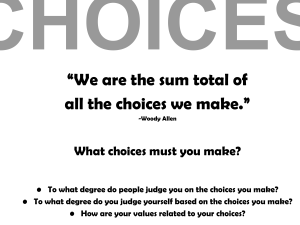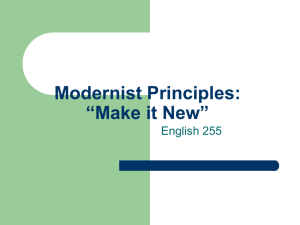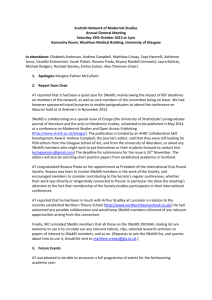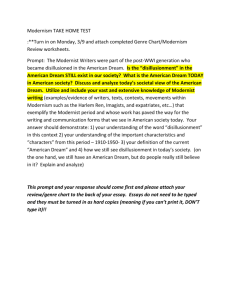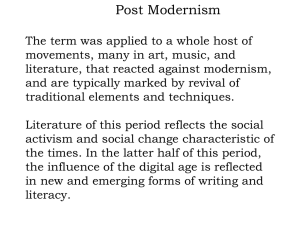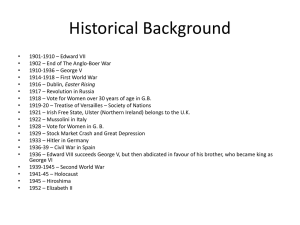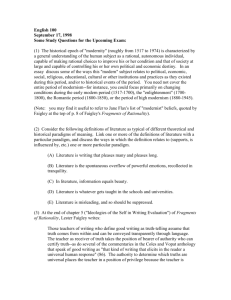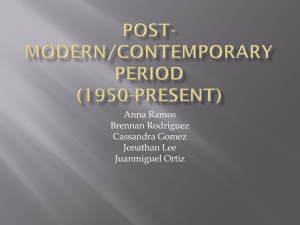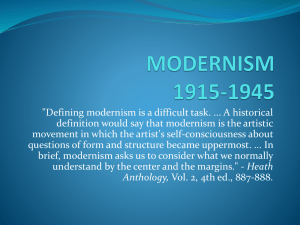File
advertisement
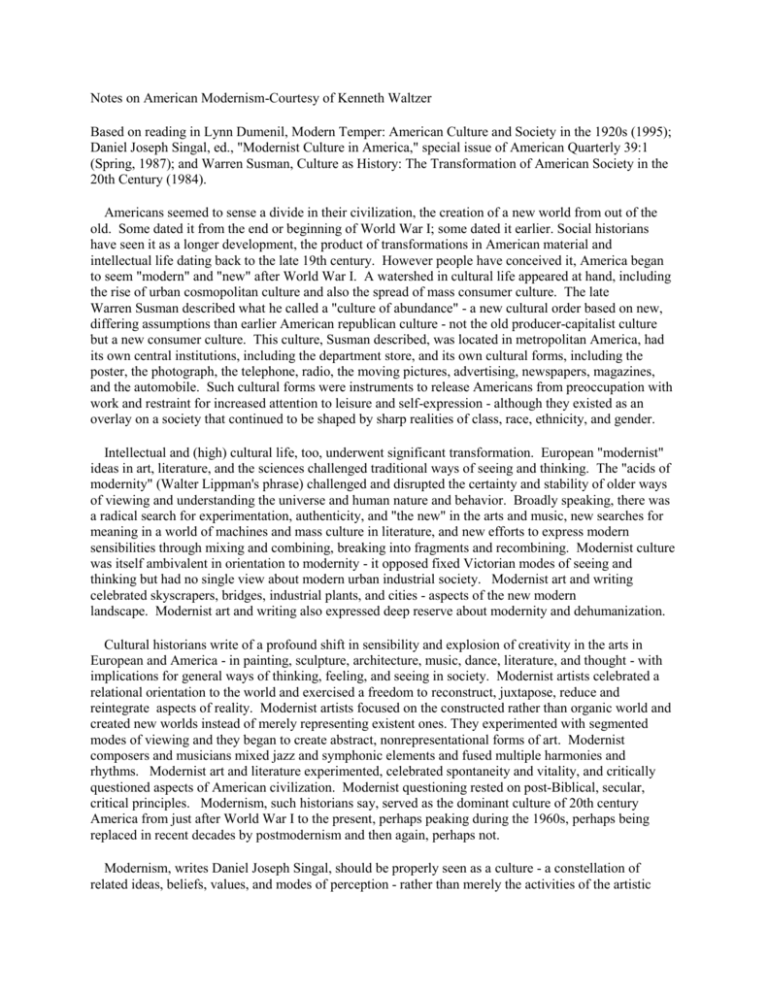
Notes on American Modernism-Courtesy of Kenneth Waltzer Based on reading in Lynn Dumenil, Modern Temper: American Culture and Society in the 1920s (1995); Daniel Joseph Singal, ed., "Modernist Culture in America," special issue of American Quarterly 39:1 (Spring, 1987); and Warren Susman, Culture as History: The Transformation of American Society in the 20th Century (1984). Americans seemed to sense a divide in their civilization, the creation of a new world from out of the old. Some dated it from the end or beginning of World War I; some dated it earlier. Social historians have seen it as a longer development, the product of transformations in American material and intellectual life dating back to the late 19th century. However people have conceived it, America began to seem "modern" and "new" after World War I. A watershed in cultural life appeared at hand, including the rise of urban cosmopolitan culture and also the spread of mass consumer culture. The late Warren Susman described what he called a "culture of abundance" - a new cultural order based on new, differing assumptions than earlier American republican culture - not the old producer-capitalist culture but a new consumer culture. This culture, Susman described, was located in metropolitan America, had its own central institutions, including the department store, and its own cultural forms, including the poster, the photograph, the telephone, radio, the moving pictures, advertising, newspapers, magazines, and the automobile. Such cultural forms were instruments to release Americans from preoccupation with work and restraint for increased attention to leisure and self-expression - although they existed as an overlay on a society that continued to be shaped by sharp realities of class, race, ethnicity, and gender. Intellectual and (high) cultural life, too, underwent significant transformation. European "modernist" ideas in art, literature, and the sciences challenged traditional ways of seeing and thinking. The "acids of modernity" (Walter Lippman's phrase) challenged and disrupted the certainty and stability of older ways of viewing and understanding the universe and human nature and behavior. Broadly speaking, there was a radical search for experimentation, authenticity, and "the new" in the arts and music, new searches for meaning in a world of machines and mass culture in literature, and new efforts to express modern sensibilities through mixing and combining, breaking into fragments and recombining. Modernist culture was itself ambivalent in orientation to modernity - it opposed fixed Victorian modes of seeing and thinking but had no single view about modern urban industrial society. Modernist art and writing celebrated skyscrapers, bridges, industrial plants, and cities - aspects of the new modern landscape. Modernist art and writing also expressed deep reserve about modernity and dehumanization. Cultural historians write of a profound shift in sensibility and explosion of creativity in the arts in European and America - in painting, sculpture, architecture, music, dance, literature, and thought - with implications for general ways of thinking, feeling, and seeing in society. Modernist artists celebrated a relational orientation to the world and exercised a freedom to reconstruct, juxtapose, reduce and reintegrate aspects of reality. Modernist artists focused on the constructed rather than organic world and created new worlds instead of merely representing existent ones. They experimented with segmented modes of viewing and they began to create abstract, nonrepresentational forms of art. Modernist composers and musicians mixed jazz and symphonic elements and fused multiple harmonies and rhythms. Modernist art and literature experimented, celebrated spontaneity and vitality, and critically questioned aspects of American civilization. Modernist questioning rested on post-Biblical, secular, critical principles. Modernism, such historians say, served as the dominant culture of 20th century America from just after World War I to the present, perhaps peaking during the 1960s, perhaps being replaced in recent decades by postmodernism and then again, perhaps not. Modernism, writes Daniel Joseph Singal, should be properly seen as a culture - a constellation of related ideas, beliefs, values, and modes of perception - rather than merely the activities of the artistic avant-garde. It is to be treated much like Victorianism or the Enlightenment - as an outlook, with key ideas, assumptions, ways of seeing and being. The Victorians dichotomized between human and civilized life, animal and savage life. The Modernists broke down such boundaries, opening themselves to dynamic processes and new combinations and understandings and to the range and complexity of human experience. Modernism, says Singal, sought to reconnect and integrate what Victorians had divided - the human and animal, civilized and savage. It also sought to find ways to include, blend, and mix Americans in a polyglot, democratic pluralism. Randolph Bourne expressed sensibilities of American Modernism in writing about a "Trans-National America." American movies, popular music, urban cabarets, dancing, American popular culture in general, expressed similar tendencies, relaxing some of the boundaries between Anglo-Americans and ethnics, whites and blacks, men and women, and celebrating dynamic mixing, fusing, and interacting. Modernism was a global phenomenon, beginning in Europe and spreading to America. Modernism was also a melange of many movements in multiple spheres, art, music, dance, literature, with international origins and complex global interactions. Europeans influenced Americans. Americans expatriated to Europe. Then, as Europe erupted in war and murder, Europeans expatriated in larger numbers to America. Modernism also had its ethnic and racial forms. The Harlem Renaissance was an expression of Afro-American modernism. Through all such interactions and mutual influences, an American modernism can be said to have originated by the 1920s and developed into an American style, then consolidated during the 1930s- 1940s, aided by the flight of European modernists to America. American modernism was comprised of numerous elements, Freud, Picasso, the skyscraper, the bridge, the city, the futuristic lines of motor car, the moving picture, the radical spontaneity and mixing of jazz, the fusions of modern American symphonies. Opposed to modernism was an older small town Protestant culture, Biblical in foundation, religious rather than secular, and uncritical. -KENNETH WALTZER Director - Center for Integrative Studies in Arts & Humanities

